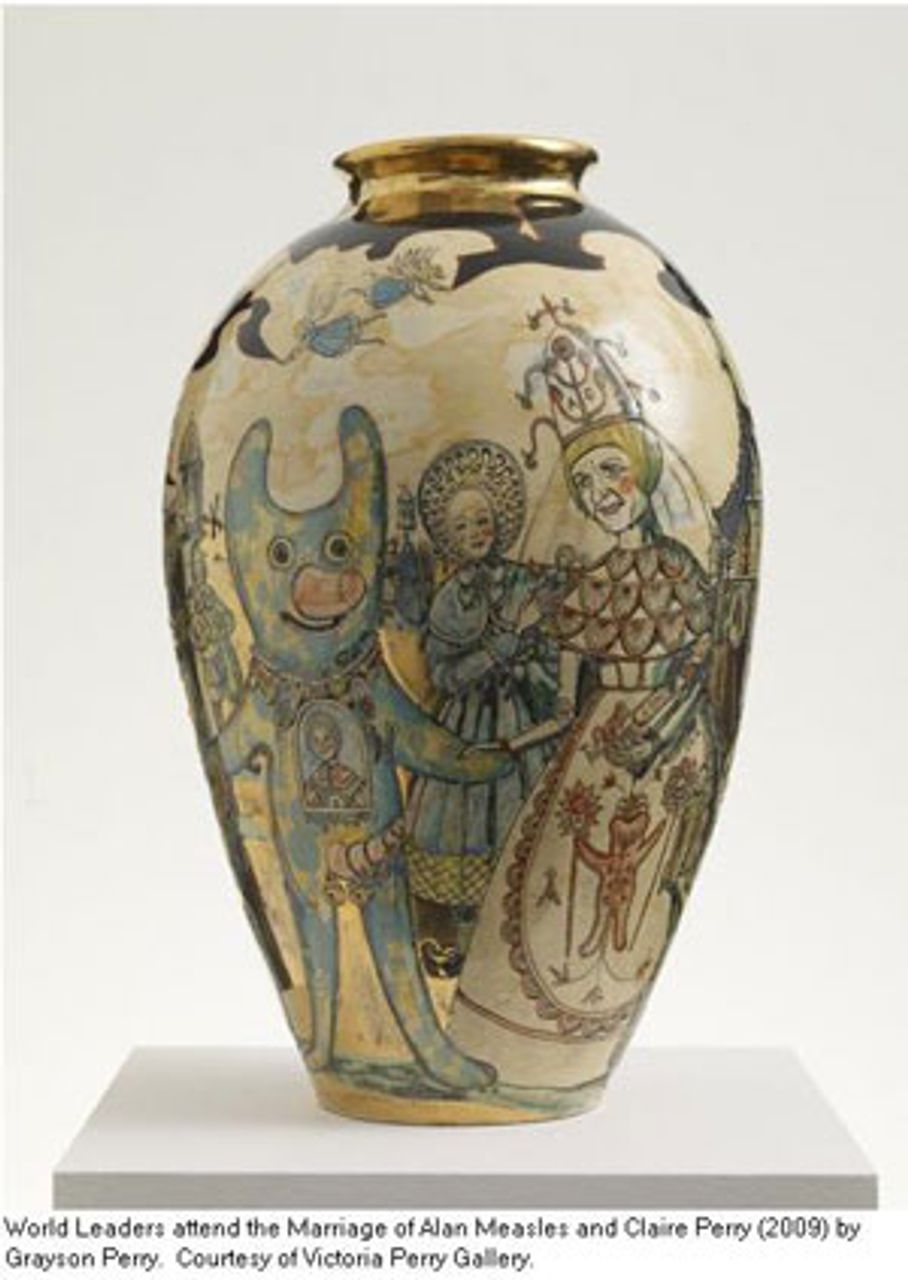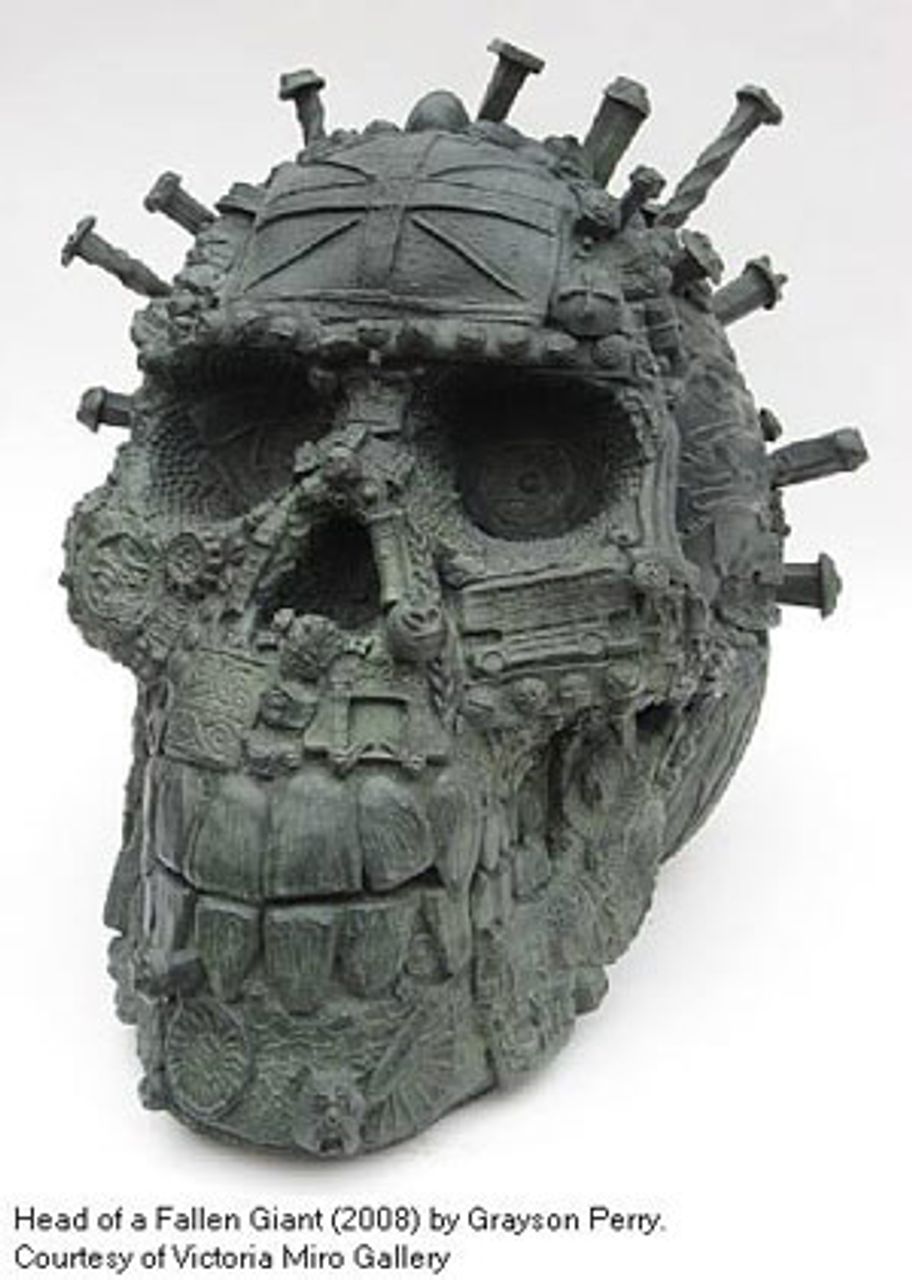The huge 3-by-15-metre “The Walthamstow Tapestry,” created by ceramic artist Grayson Perry, is a sensitive depiction of the journey through life. The tapestry was the highlight of a brief exhibition at the Victoria Miro Gallery in London last month, which also saw the display of Perry’s hallmark ceramics for which he won the Turner Prize in 2003.

Because of the biting political, social and sexual criticism he employs, Perry has been likened to eighteenth- and nineteenth-century caricaturists such as William Hogarth, whom he admires because “there’s something about the warm working class element of his work,” and twentieth-century Expressionists Otto Dix and George Grosz.
Though his work is highly autobiographical, Perry is also an observer of social reality. As he explains in his recent autobiography, “there’s branding and class; religion and folklore; sex and gender, war and politics; aesthetics and pottery; the art world and psychotherapy and inner worlds and these are the things that still interest me.” But he is then quick to point out in a telling aside, “I don’t always aspire to great narrative, or to intellectual, social or political heights; sometimes I just make something in pretty colours.”
“The Walthamstow Tapestry” is dominated by a river of blood linking a graphic childbirth scene, through the seven ages of man to eventual death. Small images are strewn across the tapestry, surrounded by phrases sewn into the fabric such as a “ship of fools” and the names of failed firms and banks (Enron, Merrill Lynch, and Northern Rock). In the centre is what Perry calls the “Madonna of the Chanel handbag,” an icon of consumerism. Fashion he adds is “inveigling into our minds” like “a voracious monster that chomps its way through youthful creativity.”
The tapestry was inspired by Perry’s interest in Sumatran batik designs and makes reference to the Bayeux Tapestry, the tale of the eleventh-century Norman Conquest of England, and to Walthamstow where the socialist and artist William Morris was born. Morris, according to Perry, “had this dilemma in that he wanted things to be beautiful and handmade and yet that immediately made them so expensive that only the rich could afford them.” He hopes that this dilemma will be overcome by Internet and digital technology delivery systems that “will free the individual maker craftsman-artist from the need to have a factory or a huge infrastructure.” “The Walthamstow Tapestry” was woven by a huge computerised loom in Belgium to Perry’s design.

On the gallery wall opposite the tapestry was a large print, “Map of Nowhere” (2008), a pun on Thomas More’s Utopia (from the Greek ou-topos meaning “No Place”). It is based on the huge medieval Ebstorf map, but instead of Jesus Christ depicted as the body of the world with his head at the top of the map, Perry has substituted himself. In place of biblical quotations surrounding Jesus, Perry is assailed by hackneyed phrases such as “living-the dream” or “binge-drinking.”
Also on display were about half a dozen new ceramic pots. They are complex pieces employing many techniques, including the use of photographic transfers, lustres and drawings cut into the clay. Perry works on about 10 pots at a time, each of which can take two to three months to complete. “I am a great believer in pattern and ornateness. I was never into minimalism…. It aspires to remove itself from the mess of reality. My own style is more human,” Perry explains.
On the “Westfield Vase,” Perry has inscribed the map of the Westfield shopping centre in West London, which opened just as the recession started. Perry juxtaposes the regimented rows of shops with bold “organic” gold lines, commenting, “In years to come we’ll look at them [the stores] with the same bemusement we look at the gods of the past.”

On another pot, “World Leaders Attend the Marriage of Alan Measles and Claire Perry” (2009), the artist unites two of his recurring images, a teddy bear and himself dressed in women’s clothes, to whom Barack Obama, Gordon Brown and Nicolas Sarkozy pay homage. The ceremony represents a comic reconciliation between the struggling masculine and feminine sides of Perry’s nature, which lay behind much of his past work and helped produce its graphic and often violent sexual imagery. Perry seems a much happier person these days.
Grayson Perry was born in 1960 in Essex—a county that developed rapidly after World War Two as Londoners, displaced by the bombing were rehoused in sprawling dormitory towns. The county became the home of the huge Ford Dagenham factory and was synonymous with the upwardly mobile “Essex man” stereotype of the Thatcher years.
When Perry was seven, his father left after his mother took up with the local milkman. Perry describes the departure of his father and his replacement by a bullying stepfather as the “biggest blow.” Family life was “fairly typical, with a bit of violence and a lot of dysfunction,” he adds.
Perry says he retreated into a fantasy world, where his teddy bear Alan Measles fought his battles, becoming “my surrogate father, the leader of an imaginary world, a benign dictator and an invulnerable hero all rolled into one.” At the same time, his vulnerability and feelings of rejection were expressed through his developing transvestitism. “Being a transvestite is not pretending to be a woman,” Perry explains. “It’s about putting on clothes that gave me the feeling I wanted…the absolute distilled essence of femininity…the absolute antithesis of the macho.”
When Perry’s parents found out about his dressing up, he was subjected to regular “absolutely useless” visits to the doctors to find a cure and finally forced out of the home.
Perry attended art college and in the early 1980s joined the “Neo-Naturists,” a group dedicated to a revival of the “true sixties spirit” and involving a lot of naked bodies smeared with body paint and food. “Doing naff things seriously in the nude,” he reflects today.
The group’s founder, Christine Binnie, introduced Perry to ceramics in 1983. He held his first exhibition in 1989, an “angry young punk trying to shock people,” but more thoughtful works began to emerge.
The inspiration for “Tragedy of ordinary life” (1996) “was the dissonance between a beautiful piece of music [Perry was listening to] and seeing a poor downtrodden person trudging past my [studio] window, a bag lady or a drunk old man.” Perry explains that “the title is about that schism between art and everyday, working class reality.”
In 2006, Perry curated “The Charms of Lincolnshire” show. He made 20 pots and a small bronze child’s coffin embedded with nails, entitled “Angel of the South.” He made this to contrast with Anthony Gormley’s huge “Angel of the North,” which stands on a hill outside Gateshead. Whereas Gormley’s monument was a celebration of Victorian industrial might, Perry dedicated his piece to the victims, particularly children, of Victorian colonialist expansion.
“The Charms of Lincolnshire” expressed intense nostalgia for places, people and traditions long gone, but at the same time Perry bitterly criticised the cliché of the rural idyll, quoting Carl Jung’s phrase, “Sentimentality is a superstructure covering brutality.”
That nostalgia is also evident in the current touring “Unpopular Culture” exhibition that Perry has curated. Scouring through pictures of some 7,500 postwar works held by the Arts Council, he selected a number “from an era when art wasn’t fashionable.” He recounts how “The first time I trawled through the catalogues of the Collection I was drawn to these three distinct categories of art, which are bound together both by the period of their inception and their ineffable sense of mood; subtle, sensitive, lyrical and quiet in contrast to today when much art can seem like shouty advertisements for concepts or personalities. I also felt a need to confront the hackneyed version of the recent past that is the default mode of the nostalgia industry. Take the swinging sixties—this psychedelic, mini-driving, mini-skirt wearing, Beatles-loving supposed glory age which I suspect was really only enjoyed by a minority. This exhibition shows another side.”

Most poignant are photographs of working class life by the likes of David Hurn, Tony Ray-Jones and Patrick Ward. Perry also made art works in response to the Arts Council collection. “Head of a fallen giant” (2008) contrasts with Damien Hirst’s diamond-encrusted skull, a symbol of “financial” Britain before the crash. Perry’s work is all about loss of empire and maritime power. The artist describes it as something dragged out of the sea and peppered with “the all-hallowed tribal symbols of England, barnacles on homus anglicus.”
Perry claims, “I’m perhaps more self-conscious than some artists of the mechanisms that make me who I am. They’re happy to ride the waves of their lives but I want to see how the waves work.”
A noble aim. But there are problems in and limitations to his approach. Comments such as “Taste is what defines the classes now, not economics” and “If we all admitted that evil exists inside each of us, we would be less polarised. In the end we are all fighting ourselves, our own internal nature” show that Perry has little grasp of the real driving forces behind social and political developments. As interesting and serious and varied as his work may be, it goes so far and no further.
His tendency to blame humanity for its problems leads to some bleak and self-absorbed conclusions (and has inevitable consequences for his art), reflected in his citing the assertion of well-known existentialist psychotherapist Irvin Yalom, “You will die, you are alone, there isn’t a god and life is meaningless apart from the meaning you give to it.”
A slideshow of “The Walthamstow Tapestry” exhibition can be found on http://www.victoria-miro.com/artists/_12/ and of “The Charms of Lincolnshire” exhibition on http://www.victoria-miro.com/exhibitions/_369/.
“Unpopular Culture” lasts until January 3, 2010, at the Victoria Art Gallery, Bath, and finishes at the Mead Gallery, Coventry (January 23-March 13, 2010).
